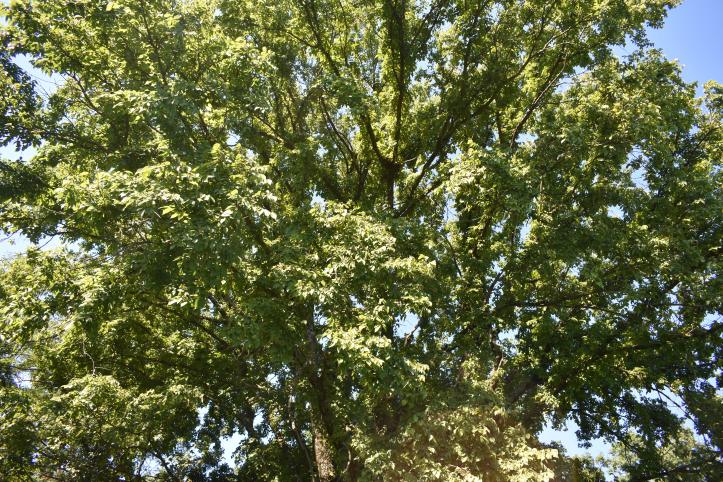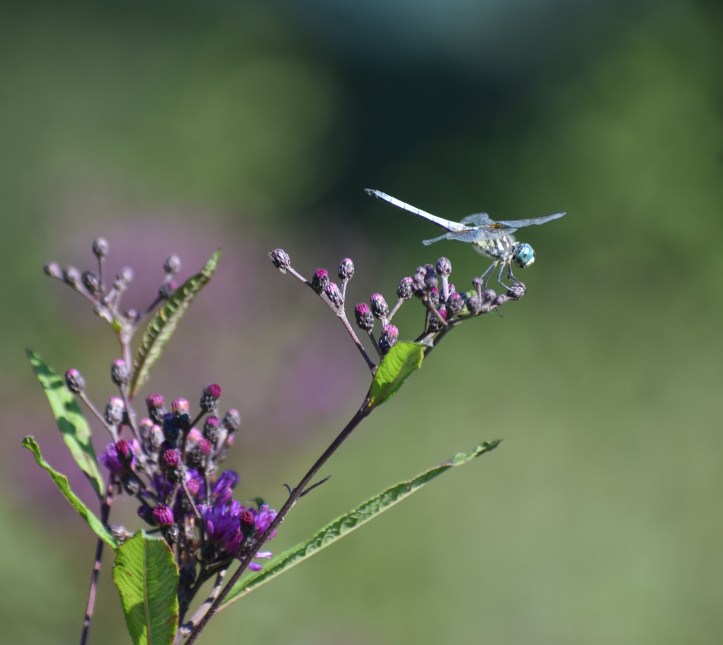
It was a crystal blue sky when we left the trailhead mid-morning on this August day, and somewhat surprisingly, one object in view was the moon, which we could see with great clarity.
Morning View Heritage Area is a 224 acre preserve that is managed by the Kenton County Conservation District and is an official Kentucky State Nature Preserve. The property was originally home to John and Matilda Steinhauser, and later six generations of descendants. For 154 years the family operated a dairy farm on this hilly landscape.
It was purchased with funds from the Kentucky Heritage Land Conservation Fund and the U.S. Fish and Wildlife Service. Trail development and maintenance has largely been done by volunteers of the Sierra Club’s Northern Kentucky Group.
The trail network is a conglomeration of paths that take you through different ecosystems.

We started on the Hult’s Wetland Trail, which featured a meadow with some small depressed areas that held water.

It was a widely mowed path that was bordered by numerous flowering field plants.

Ironweed, Butterfly Weed, Queen Anne’s Lace, and Joe-pye Weed.




But the star of the show was the Swamp Rose Mallow, a member of the Hibiscus family. As the name suggest it occurs in wetlands, and its flowers can be 6 to 7 inches wide.

As we were about to exit the meadow and head onto the Dickerson Trail,

we noted these colorful appendages on a cluster of Sassafras trees. They are the remnant fruiting structures of the trees, and clearly the wildlife has been feasting on them as there was only an occasional berry remaining.


The birds will then disperse the seeds through their digestive process.
The Dickerson Trail was challenging; acutely climbing up a steep hillside using switchbacks, and tunneling through cedar thickets.

Our endeavor was rewarded when near the top there was an opening that allowed a view of this part of the Licking River Valley.

Here we transitioned to the Kreissl Trail,

which initially was a ridge walk that entered a mature wood, and appeared to utilize an old farm lane.

There were two interesting tree findings on this part of our outing. The first was a large American Elm tree that look full of vigor from a distance.

But on closer inspection we could see dead wood within the canopy and a remarkable number of “sucker” branchlets developing on the proximal parts of the branches: The telltale signs of Dutch Elm Disease.


The disease is caused by a fungus that is transmitted by the native Elm Bark Beetle. As the beetle feeds on the elm’s bark, a naturally occurring relationship, it can deposit the non-native fungus which results in clogging of the tree’s vascular system and then branch death. The flurry of branchlet growth is the tree’s last gasp. So the battle continues, with this tree afflicted with Dutch Elm Disease one hundred years after it was first noted in North America in 1921.
The other tree sighting was a positive one, when we came upon this very mature White Oak that featured the raised bark plaques only seen in the most mature trees.

These bark crevices provide shelter for insects and bats, especially in the winter. On winter hikes in mature woods one can observe woodpeckers, nuthatches and chickadees work their way up and down a trunk, looking for a meal of the overwintering insects.
The Kreissl Trail then heads downhill into a creek valley. This part of the trail works through a meadow undergoing succession that features some large trees.


Some of the interesting plants that we saw on this outing included the Tick Trefoil, characterized by the “eyes” noted on the upper flower petal, giving the flower somewhat of a comical face appearance.


Another was Frostweed, which is also known as White Crownbeard. The name Frostweed comes from the fact that in cold weather the stem exudes water that then freezes into interesting shapes. We will have to look for that this winter.


The prairie and meadow hikes of this past summer have featured some great encounters with a tremendous number of dragonflies, and now I consider them one of the most underappreciated animals. It has caused me to reflect on the aversion that 11 year old Pat Burns had for them. As kids, my friends and I spent a lot of time in the outdoors, either fishing, playing sports, or wading in creeks. Having been frequent victims of the stings of sweat bees, honey bees, hornets and wasps, I believe that we developed an aversion for the much larger and seemingly threatening dragonfly, fearing the sting that it could deliver. We did not understand the ecology of dragonflies; that they were in fact our friends, with mosquitoes being a primary food source.
And now as an adult hiker, who moves at a slower pace and has the benefit of digital photography, I have come to appreciate the beauty of this family of insects.
Eastern Pondhawk (Female)

Eastern Pondhawk (Male)

Common Whitetail Skimmer

Blue Dasher

Black Widow Skimmer

What I have learned this summer is that my previous generalization, that dragonflies are largely creatures of wetlands, was wrong. While they require standing water for egg laying, they will travel good distances for feeding. We have seen them in great numbers, as we did at Morning View Heritage Area, in the fields and meadows where they feast on the bounty of mosquitoes and other insects. And they animate our hikes with their graceful flight and vibrant colors.
It is always a good day when you spend time amongst the Monarchs. Here they were feasting on some Joe-pye Weed.


And finally, the simple beauty of a Field Thistle about to open.

The Keissl Trail led us back to the education barn and parking area.

In summary, a hike at Morning View Heritage Area is a good outing. It is moderately physically challenging with its vertical climb, and ecologically interesting with the variety of ecosystems. It is very well maintained. We look forward to returning to tackle the Steinhauser trail, via the Kreissl trail from the parking area, which should be even more physically challenging and offer additional outstanding vistas.
Footpathsblog.com posts are released every Sunday morning and some bonus content is added periodically. Please click on a social media icon above to follow for future posts and to make sure that you catch all our reflections on, and adventures with, the great outdoors.
Photo credits to Peggy Juengling Burns.
Overview:
Location – 15168 Decoursey Pike, Morningview, KY 41063. It is 25 miles south of downtown Cincinnati.
Parking – Large gravel lot for approximately 20 cars.
Facilities – None.
Trail Conditions – mowed path through fields and succession grasslands. Dirt path through the woods. There is approximately 300 foot elevation change but it comes over a rather short distance. Our outing was 1.3 miles. The Kreissl-Steinhauser trail combination would be a 2.4 mile hike.
Print Map Link – https://img1.wsimg.com/blobby/go/fa1397c0-ea11-4f92-aa6c-a9889ebd44c5/downloads/MVHA-trail-map-1-pg-color-18Jan2022%20-%208×11.pdf?ver=1661851941998
Benches – None
Picnic Tables – None
Kids – kids 6 and over should do well here
Dogs – Prohibited
Suggested Paired Hikes – none
Links:
https://kccdky.org/ky-heritage-lands
Another great trail blog. I wonder why dragonflies hover over the hood of my car, I have seen it many times at home and in large parking lots. This series of trails reminds me of the Independence Cemetery Trails, mowed trails through pollinator fields. Independence Cemetery opens three-mile trail system through expansive pollinator habitat | NKyTribune
| | | | | |
|
| | | | Independence Cemetery opens three-mile trail system through expansive po…
By Gayle PilleSpecial to NKyTribuneIndependence Cemetery has recently opened one of the largest contiguous polli… |
|
|
John
Thanks John. You got a preview on that article. I accidentally published it mid week while proofing it. Gayle has recommended the Independence Cemetery trails to me. Should still be a good time to visit.
Learning so much from these awesome blogs – thanks for sharing your knowledge. We have dragonflies that “hover” over our pool, now I know why. This trail is definitely on my list of must-do’s, especially with fall coming.
Yes, I am looking for a later fall day with leaf change so that the views from the scenic overlook on the Steinhauser Trail will be colorful.